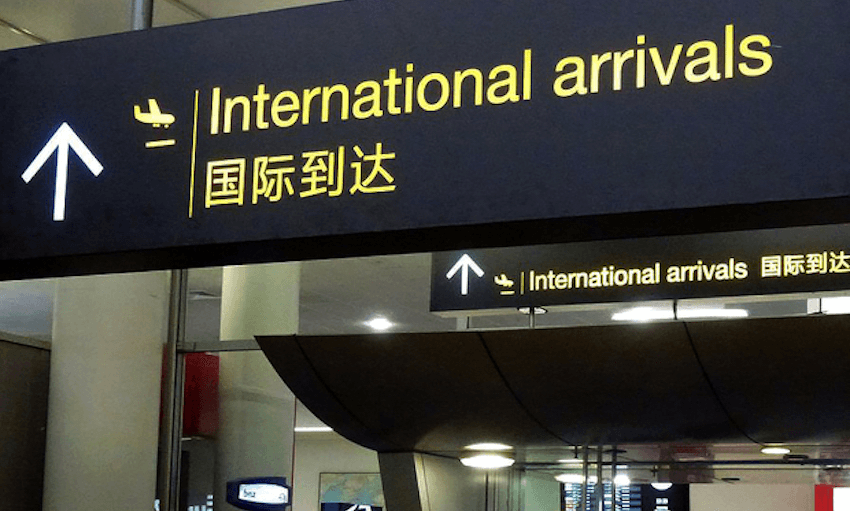Racial profiling by Immigration NZ is a tale as old as time (Dawn Raids anyone?), but if the ‘harm team’ has its way they’ll be workshopping it into our very own dystopian scifi blockbuster, writes Tze Ming Mok.
Immigration NZ has apparently caught its own minister off guard by talking openly about plans for a Minority Report-style pre-crime prevention unit. The department has been running a pilot programme for 18 months to develop a statistical risk-profiling model that it plans to use to undertake pre-emptive deportations and other punitive measures.
The unselfconsciousness of it was amazing. In case you didn’t quite catch his drift, the INZ spokesperson unabashedly repeated, over and over, “We’ll move to deport that person at the first available opportunity so they don’t have a chance to do that type of harm … We would look at building a profile of the type of person that we want to remove at the earliest possible opportunity … we think you are going to do this, that’s basically it … It’s predicting how someone is most likely to behave based on how their predecessors have behaved.”
It was kind of like watching a boot on a human face, forever, but the boot-wearer is like, “Yo, I’m playing DDR, wanna join in?”
INZ has been done for racial profiling at airports in the past, and since then has always been very careful to say “we’re not racially profiling”. It even seemed to get its minister, Iain Lees-Galloway, to deliver their line that “it wasn’t racial profiling and a range of data was being considered”.
Indeed, the range of data includes ethnic group, sex, age, and country of origin. Guess what, doofuses? Gender, age, and nationality are all prohibited grounds for discrimination under the Human Rights Act too! Oops. Also, if a person is profiled because of a combination of their race, age, gender and country of origin, the racism doesn’t get diluted somehow. But that’s right, INZ just said it wasn’t being racist because it was being sexist and ageist too.
But are the comparisons to Minority Report overblown? Yes! Because we do not have literal psychics floating in a gloop-bath – we just have some shady statistical model. It’s more like a super dumbed-down version of Avengers: Age of Ultron – already the worst Avengers movie. In Age of Ultron, Tony Stark’s risk modelling algorithm allows for the pre-emptive destruction of all security threats. The AI he creates very rationally decides that the best move to protect the planet would be to wipe out humanity. Actually not a terrible idea once they worked their way up to it, but within the first 15 minutes of the movie I was yelling at the screen, “THERE IS NO SUCH THING AS A PERFECT PREDICTIVE MODEL.”
I am not privy to the statistical methods being used by INZ, but risk modelling of this kind cannot tell the future for an individual person. It is a prediction of averages, based on the actions of other people in the past, and is always subject to error. For INZ to announce that it plans to take pre-emptive punitive measures against individual people based on the past actions of others in the same demographic categories, is a very clear example of discriminatory treatment by the government. But it freaks us out for other reasons. It’s a denial of the existence of human agency and freedom, in the service of a punitive state.
It was bleak to see such a glib and unselfconscious promotion of this coming from a government department. Why did anyone in NZ Immigration think that this was remotely okay? I suspect it’s because because statistical risk modelling is so widely used throughout the public sector, it may as well be the wallpaper. You don’t think anything of it, unless it starts to move.
The way risk modelling is used in the “social investment” model set up by the last government has been heavily and deservedly criticised, but one of the arguments in its defence is that it would only be used to target funds towards support for potentially vulnerable groups – not to remove entitlements or dish out punishments. Of course, whether it works like this is questionable. And now INZ is forging ahead with bracing honesty about what it really wants from the data. Initially I thought that the people behind this policy were either too young to have seen Minority Report, or too old for Age of Ultron, or too scared to watch Black Mirror. But maybe they did watch them, and simply thought, “man, the future of government is bright.”
Tze Ming Mok has a background in human rights and social research methods. She is also a former sworn officer of the NZ Immigration Service.
This section is made possible by Simplicity, New Zealand’s fastest growing KiwiSaver scheme. As a nonprofit, Simplicity only charges members what it costs to invest their money. It already has more than 12,500 plus members who, together, are saving more than $3.8 million annually in fees. This year, New Zealanders will pay more than $525 million in KiwiSaver fees. Why pay more than you need to? It takes two minutes to switch. Grab your IRD # and driver’s licence. It really is that simple.
